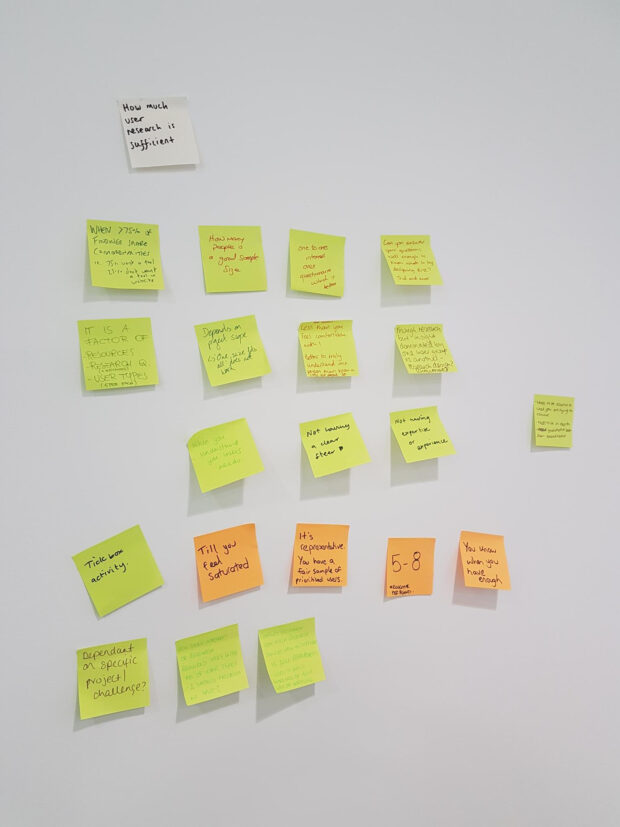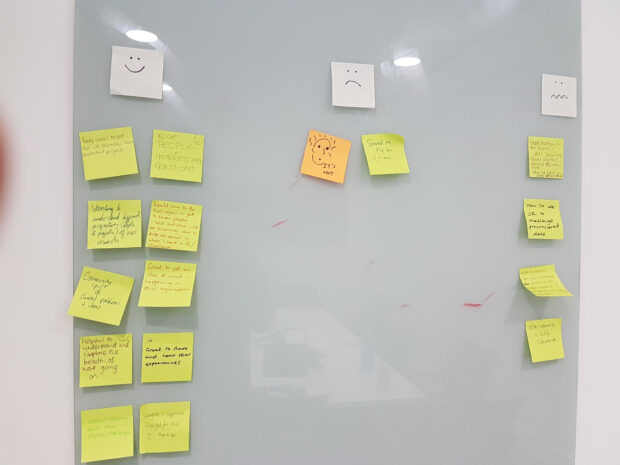The Health Product People community was started in January 2018 to bring together people working on digital services across the health and care space. We wanted to bring together people to share ideas, collaborate and work together to solve problems. The Health Product People community builds on the good work of the cross-government product and service community.
We had our third event last week. The event was focused on how to conduct a discovery successfully. We wanted to answer the following:
- how much user research is sufficient?
- what do teams expect in discovery?
- what outputs are expected in discovery?
The event was split into four parts:
- introductions
- show and tell
- discussion
- retrospective
Introductions
First, we got all the necessary introductions out of the way. We asked the group to share who they were, what they were working on and one challenge they were facing. We put all the challenges on post-it notes and put them on the wall so we could go back to them later.
Thankfully, turnout was impressive with representatives from the Department of Health and Social Care (DHSC), Public Health England (PHE) and the Human Tissue Authority (HTA). So a nice mix to get the conversation flowing.
Show and tell from PHE
We had a team from PHE presenting on processes they established for their discovery around user research.
They talked about how to design user research studies. The key takeaway is for teams to start small and make sure questions asked align with stated goals and objectives.
The team stressed the importance of anonymising data, asking for consent and then storing it safely – important topics, especially in light of GDPR.
How much user research is sufficient?

The biggest challenge facing teams in discovery is around how much user research is enough.
Here are a few questions/comments from the group:
- “how many people is a good sample size?”
- “can you answer your questions well enough to know what to try designing first?”
- “a one-size-fits-all approach does not work”
In answer to the questions above, the community came up with the following answers:
- as a minimum, for each user type, speak to 5 users
- prioritise your users – speak to the most important first. It’s hard to speak to all user groups, especially if your discovery is short
- you don't have to do all your user research in one go
- have an ongoing plan for user research
- work with senior stakeholders as early as possible so that you can meet their expectations
- “you stop when you truly understand your user needs”
It’s important to remember that there isn’t any easy answer here. It’s messy and depends on your resources, timescales and the size of the service
"More challenges. More challenges"
We didn’t have an opportunity to go through all of these, but here are the common challenges the community mentioned:
- a discovery is a journey into the unknown
- not knowing how to prepare for a discovery
- how to encourage people to be open to new methods
- prioritising what to work on
- what workshops are valuable and how many should you do
- not sure what tools to use
- presenting work to senior stakeholders
- how digital can work better with policy professionals
- getting to grips with the public sector
- ever-moving completion rates
- internal and external government processes
- navigating procurement
There is a plan to address these challenges in subsequent Health Product People events.
Being inclusive
It’s important that everyone is heard. Everyone has something of value to contribute. Community events tend to be dominated by extroverts, so making sure everyone in the room has the space to think and speak is important. For our event, we asked people to write down their thoughts on post-it notes.
This gives introverted people a chance to really think about a question. We also gave people the time to explain their thoughts without interruption.
We will continue to be inclusive and we are open to comments/suggestions on how to make our next event even better.
Retrospective – reflecting on the event

The retrospective was overwhelmingly positive. People loved hearing about real-life examples around digital transformation, different perspectives and how supportive the community was. The time just flew by, and by the end people were disappointed it had ended!
We know our next event can be better. We assumed that everyone understood ‘digital’ terminology. In the next event, we will assume no prior knowledge. We will also send pre-reading beforehand to help bring people up to speed.
What the community wants to see next
We were overwhelmed with the turnout and the energy in the room. There’s a passion and drive to build services that truly meet the needs of users. Going forward, the community plans to share work with each other more widely.
Here’s some of the things we agreed to share:
- PHE’s protocol for sharing data
- what ‘spider webs’ are (user research technique)
- how to store user research, especially in light of GDPR
- accessibility and assisted digital information
- product communities across government
For now, this information will be shared via email. Going forward, we will look to see how we can better disseminate information across the community. For our next event, we will explore the alpha stage. This event should take place sometime in July (in London and Leeds). We will explore options for dialing in and having community events in different locations.
Joining the Health Product People community

Do you work in the health and care space? Interested in sharing your ideas and work with others?
If you answered yes to any of the questions above, please contact dharmesh.chauhan@digital.dh.gov.uk or colin.pattinson@digital.dh.gov.uk with information about who you are, your role and the service you are working on.
We look forward to hearing from you.